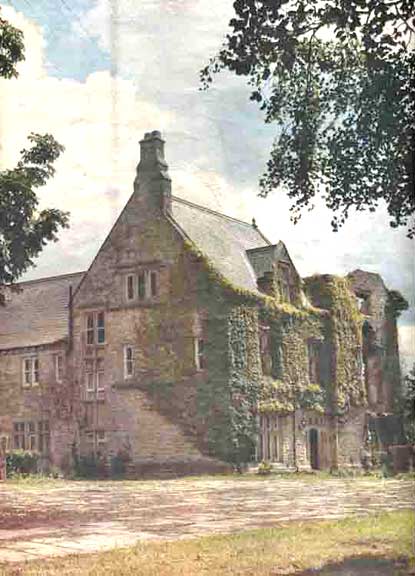Riseborough
Hall
(Research
by Gill Chappell)
Riseborough Hall lies to the North of the parish of Normandy in the Wapentake of Ryedale – an ancient dwelling house in an ancient
district.
The name Hall is derived from that of a “great hall” , being the main room of
a royal
palace,
nobleman's castle or a
large
manor house
in the
Middle Ages,
and in the
country houses
of the 16th and early 17th centuries.
castle or a
large
manor house
in the
Middle Ages,
and in the
country houses
of the 16th and early 17th centuries.
The Hall sits proudly on the summit of a Linear Terminal Moraine
(Thornton-Riseborough Hill) formed at the very end of the last Ice Age
(approximately 20 000 years ago) by the deposition of material exposed after a
glacier had retreated. It commands a strategic position, rising
approximately 200 feet above the Vale of Pickering with commanding 360 degree
vistas across Ryedale, the North Yorkshire Moors, the Howardian Hills and the
Yorkshire Wolds.
Its location is no happy accident, but rather the carefully calculated
positioning by the ancients who first inhabited the hill and sought to protect
themselves from both aggressors and the elements. It stands firm with its back
against the bitter north easterly winds blowing directly across from the North
Yorkshire Moors, and looks forward in a South Westerly direction taking
advantage of the views and the warming rays of the Sun. It lies just below
the nearby trig point allowing cold winds to skim its roofs and carry on down
Orchard Hill, with Indigenous trees painstakingly planted so as to cloak the
Hall and shield it from the worst of the Icy blasts that can ensue.
The Hall is subject of much local folklore, and amid stories of Monastic and
Crown connections and associations with Romans, the De-Bulmer/De- Wilton
Families, Templar Knights and Crusaders, Cromwell and his MP Luke Robinson - a
Lord Lieutenant of the County, the Rowntrees (the famous confectioner family)
and a prominent Methodist Minister, the Hall has been quite rightly described
by a Local Historian as a House of National Historic interest.
Local tales talk of priest holes and secret tunnels, and subterranean
connections with other local country residences. The Hall can boast of
resident ghosts, lay lines, and ancient Yews planted in
Neolithic
times to mark burial places when England was largely covered in forest,
and has visible evidence of medieval strip farming within its grounds and
close by.
It is an ancient manor granted at the time of the Norman invasion and is
recorded in the [Doomsday Book]; it has ancient dressed and worked
stone, carvings believed to be Roman in origin, a Tudor Fireplace; priory
style stone arches, early deep wells and the remnants of a King John House.
The current owners have managed to research and establish 1000 years of
ownership which amazingly lies with only 6 families (the current owners being
the 6th), and are in the middle of a ten year sympathetic
restoration project. The house has been the subject of much remodelling over
the years and throughout the ages, with each owner reflecting the contemporary
construction and decorative styles of their day in the additions that they
made. Notable owners/constructors of Riseborough Hall were Bertrum de Bulmer,
Sir Arthur Robinson, Thomas Harrison, George Wynn Tweedy and Dr Thomas Frank,
all putting their unique stamp on the property.
Samuel Pepys mentioned the Riseborough Hall owner and Cromwellian long
Parliamentarian, Luke Robinson in his famous diary, and there is even a
Cavalier's Ballad immortalising their adversary and describing him as a
“Snarling Northern
Tyke”.
Dr Thomas Frank (a much loved and fondly thought of local Doctor) undoubtedly
saved the Hall from demolition and redevelopment in the early 1960s by
purchasing the ruins and partially restoring the Victorian wing (approximately
30% of the house footprint) in the 1970s creating a family home once more.
The Hall had lain in ruins following a devastating fire on 16th
October 1952 whilst in the ownership of
Mr.
& Mrs. George Tweedie which sadly raised the building to the ground,
rendering it a burnt out shell and destroying much historic content.
Mr. and Mrs. Tweedie already in their twilight years took the Insurance money
paid out for the fire damaged house and moved into a cottage that they owned
in nearby Aislaby to live out their days. For local children the ruins
were a mysterious and intriguing playground, enhanced by the tales of the
“grey lady ghost“ and motor vehicles inexplicably stalling out side the
entrance gates. Evacuee at the
Hall
As the restoration progresses the Hall is
relinquishing its history little by little and undoubtedly has many more
secrets to reveal.
© Mark and Gill
Chappell
Riseborough Hall
Top